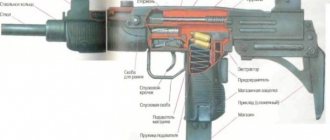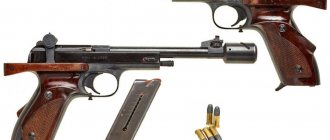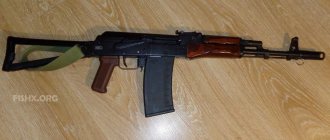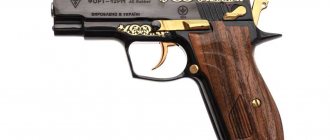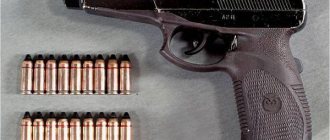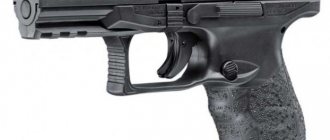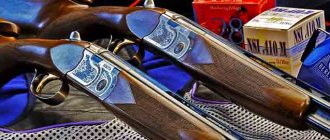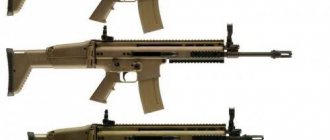History of creation
His friends called him Uzi, but Major Uziel Gal never wanted that name attached to the weapon he developed. But the Israelis simply ignored his request, and the Uzi submachine gun, one of the most iconic firearms in history, was born.
For Uzi, the creation story begins on May 14, 1948, when the state of Israel emerged, which was immediately attacked by the neighbors of the new country. Although the young Israelis fought off the attacks, it was clear that the new nation-state needed new firearms to replace the outdated weapons of World War II.
Uziel Gal was based on the Czech CZ25 submachine gun, developed in the late 1940s, which used an open bolt and a magazine inserted into the pistol grip. These main features formed the basis of the Uzi design.
Uzis were produced in several modifications, including two shortened versions (mini and micro versions). The most recent version of the Uzi Pro is still used by some special forces units.
Many people mistakenly use the name “Uzi machine”. In fact, this is not the case, because this weapon exclusively uses the 9 mm pistol cartridge. Therefore, the Uzi is a submachine gun, not an assault rifle.
Patriot of Israel
Gal's interest in creating weapons began in childhood, when at the age of 15 he created an automatic crossbow. He soon joined the Palmach, an elite unit of the underground Israeli army, as a weapons engineer. In 1943, he was arrested by British authorities for illegally transporting weapons and sentenced to 6 years in prison. After serving 2 years out of 6, Gal went to the IDF - the armed forces of the newly formed state - to fight in the War of Independence.
In the late 1940s, Israel Military Industries (IMI), the formerly clandestine and now official Israeli arms manufacturer, commissioned two engineers to create a decent weapon design for Israeli soldiers, primarily to replace the failed STEN submachine gun. These designers turned out to be IDF officers Lieutenant Uziel Gal and Major Haim Kara, head of the light weapons section.
Device
Gal based his weapon in part on designs for earlier Czech submachine guns, in which cartridges were fed into the chamber from a box magazine inserted into the pistol grip. The Uzi has a blowback action that travels along most of the barrel when fired. Gal combined these characteristics to create a weapon that was compact, had a lightweight loading mechanism, was reasonably stable and accurate even with automatic fire, and had good reliability.
The Uzi has a rectangular receiver with front and rear "half-round" sights on the ends of the receiver. The magazine is inserted into the pistol grip, with a round cocking handle on the receiver.
The barrel can have several different configurations. Its design ensures a very short overall length and makes the weapon insensitive to contamination. Operating on the principle of a bolt action and recoil spring, the Uzi can fire in full-automatic mode, but is also available in semi-automatic mode. It has a folding stock and can be equipped with a silencer.
The Uzi submachine gun is based on the open bolt principle. The bolt is located behind the pistol grip with the magazine. The shot occurs when the shutter is in the forward position. This arrangement offers several advantages. Firstly, the dimensions of the weapon are reduced, since most of the barrel is in the body, and secondly, the recoil is reduced, because at the moment of firing, the bolt moves forward.
The trigger has two fire modes: single and automatic. The fire switch is also a fuse. There is another automatic safety, which is located in the pistol grip; the safety on the famous Colt 1911 works on the same principle. If the hand does not clasp the grip and press the safety button, the shot will not fire.
The submachine gun has a folding metal stock.
Principle of operation
- When you press the trigger, the bolt first feeds the cartridge into the chamber
- Immediately after this there is a shot
- Under the influence of powder gases, the bolt returns to the rear position
- The cycle repeats
Recommended timing
Mandatory screening ultrasound examinations during pregnancy are carried out three times: at 11 - 14, 18 - 24 and 32 - 36 weeks. Additional research is prescribed if there are indications and if there are suspicions of possible anomalies in the development of the fetus and placenta, pathology of the amniotic fluid and the course of pregnancy. Three- and four-dimensional ultrasound is recommended at 17-18 weeks.
Women visit ultrasound 3-4 times throughout pregnancy. But at the doctor’s insistence, the procedure can be performed more often. To get the maximum benefits from 3D/4D, it is better to carry them out after 22-25 weeks, so that the fetus has time to fully form. At different times, the study allows us to obtain the following information:
- 5-12 weeks - confirm fertilization, diagnose a frozen or ectopic pregnancy, exclude any complications, chromosomal pathologies, determine the expected date of birth;
- 18-22 weeks - assess blood flow in the uterus and umbilical cord, identify fetal pathologies, determine the sex of the child, exclude entanglement, estimate the volume of amniotic fluid, see a three-dimensional image of the child;
- 33-34 weeks - determine the position of the fetus, its motor activity, examine the uteroplacental blood flow.
You can see prices for services
Characteristics in comparison with analogues
The very first analogue that comes to mind for comparison with the Israeli Uzi assault rifle is the American Mac 10 pistol. They use the same ammunition (9x19), are similar in appearance, and are designed to perform the same tasks. These are two compact PDWs that are intended to be discreet self-defense weapons.
The MAC 10 and Uzi are submachine guns that have been in service with armies for a long time, and they both use pistol cartridges. The Uzi has a longer history, having been developed in the 1940s, while the MAC 10 or Model 10 was created in 1964.
Among experts, Uzi enjoys great prestige, primarily due to the fact that the design is more reliable and less susceptible to overheating.
Mac 10 weighs almost a kilogram less than Uzi (2.8 kg for MAC 10, versus 3.5 kg for UZI)
It also wins in length (548 mm for MAC 10 and 640 mm for UZI). The MAC 10 also benefits in barrel length, so the MAC 10 can confidently be called a more compact weapon.
Another difference is the rate of fire. The Uzi has a rate of fire of 600 rounds per minute, while the Model 10 has a rate of fire of 1090.
However, despite the above advantages of the Model 10, the Uzi is still considered the best PP. The first reason is the rate of fire. Due to the smaller dimensions, barrel length, but higher rate of fire, it is more difficult to control the weapon and shoot accurately. Model 10 is more susceptible to overheating and will lose to the UZI in reliability.
Conclusion: The MAC 10 is more compact and faster-firing than the Uzi. But due to the design features, the Uzi submachine gun has better accuracy, effective firing range and reliability.
Performance characteristics (TTX) of Uzi
The barrel length is only 260 mm (10 inches). The submachine gun weighs about 4 kg with a magazine. Magazines come with 25 or 32 rounds of 9 mm caliber. The Uzi also comes in miniature versions, measuring just 460mm in length.
| Ammunition used | 9x19mm Parabellum |
| Length | 640 mm |
| Barrel length | 260 mm |
| Weight | 3.5 kg |
| Magazine capacity | 25, 32 rounds |
| Rate of fire | 600 shots /min |
| Sighting range | 200-250 m |
[edit] Uzireah
| 1 | 3 | yes | Show | Hide |
|
Advantages and disadvantages of UZI
Pros:
Simplicity of design. The weapon is easy to disassemble and clean. This significantly increases its durability.
The parts are easy to manufacture. Thanks to the abundance of stamped parts, the weapon is inexpensive to produce
High reliability. Simplicity and large design tolerances keep delays and non-feeds to a minimum.
Relatively small dimensions. The weapon can be carried secretly under a raincoat or jacket. A special shoulder holster was created for this purpose.
Good weight distribution of weapons.
Minuses
Its main drawback is that it only fires pistol ammunition. This leads to reduced, in comparison with assault rifles, accuracy, firing range, bullet speed, striking and penetrating ability. The Uzi is a melee weapon.
Aim
The Uzi is a submachine gun with a basic but functional mechanical sight with factory zeroing. The front sight consists of a simple steel blade protected by two deep steel wings on either side. The sight is adjustable for horizontal and vertical elevation. Making changes requires a special tool to loosen the scope screw.
The rear sight, protected by high metal wings, is of a diopter type with a small adjustable aperture, at 100 or 200 m. The sights are strong and reliable, effective at given ranges and allow you to quickly take aim when shooting offhand.
Combat use
At first, the weapon was popular only in the Israeli Armed Forces. It was put into service in 1956 and was used as a PDW (Personal Defense Weapon or weapon for self-defense), primarily by artillerymen and tank crews, for whom an assault rifle was too large and heavy. The weapon was used by the Israeli army during the Suez Crisis (1956), the Six Day War (1967) and the Yom Kippur War (1973).
Perhaps Uzi's most famous appearance outside of Israel occurred in March 1981, when a mentally unstable man named John Hinckley Jr. attempted to assassinate President Ronald Reagan with a .22-caliber revolver. The President was seriously wounded by the ricochet. A famous photograph from that day shows Secret Service Special Agent Robert Vanko, Uzi in hand, surveying the crowd as the President and other wounded were evacuated. The Uzi remained the Secret Service's PDW of choice well into the 1990s.
At the moment, the Uzi is not in service with the army in Israel, as it is outdated. The Uzi replaced the Tavor and M4A1 carbines.
Modifications
Uzi has several modifications.
- Mini Uzi
The Mini Uzi has a folding stock. Due to the weapon's downsizing, the receiver is smaller, the bolt is smaller, and the barrel is shortened to approximately 7.75 inches (196 mm). The rate of fire is 950 rounds per minute. Production began in 1980.
- Micro Uzi
The Micro Uzi is scaled down even more than the Mini Uzi; It has a 4.7-inch barrel and fires at 1,200 rounds per minute. A stock can also be used on this weapon. Production began in 1983.
- Uzi Pro
In this variant of the Micro Uzi, the cocking handle has been moved to the left side of the receiver. The grip and fore-end are made of polymer, and the grip design has been modified to allow two-handed grip, which would improve shooting technique and allow for more precise control of the weapon. The Uzi Pro has two rails on the barrel and one on top for mounting scopes and other tactical equipment. Production began in 2010.
- Norinco Model 320
An unlicensed copy of an Uzi made in the mid-1990s in China by Norinco, with a wooden stock.
Chilled Uzi
Quite a rare and very expensive example. Remade in Russia from the original Israeli Uzi. Uses a 10x31 blank cartridge. All functions and controls are retained. The only change is the deactivation of the weapon's warheads to eliminate the possibility of firing live ammunition.
Traumatic Ultrasound
At the moment, there is no sample that completely copies the combat prototype. However, in 2009, a traumatic pistol was created in Turkey, created in the image and likeness of the Uzi, which is called the Zoraki 925. It is extremely vaguely reminiscent of the Uzi, because it has the same magazine mounting system in the handle, and it also has similar features in appearance.
The submachine gun is manufactured by Zoraki in Turkey, uses a 9 mm PAK cartridge, has an automatic firing mode and a magazine capacity of 16 to 25 pieces.
This submachine gun was copied and remade by a Russian company with some changes (10-round magazine and no automatic fire mode), because otherwise the pistol would not have passed the requirements of Russian legislation.
Pneumatic versions
Produced by several companies. The largest of them: Umarex, Gletcher. In general, they differ little from each other. They use CO2 canisters and shoot 4.5 mm balls. They have an external replica of the original, but differ significantly in weight. All controls (including the automatic safety in the handle) are retained. Sold without a license.
Recommendations for using Uzi air pistols
Perhaps the main recommendation when using the Uzi submachine gun is constant care of the barrel and main mechanisms. This includes cleaning and lubricating the inside of the barrel.
- Constant care of the insides of the pneumatic is required. Including cleaning and lubricating the inner barrel.
- Don't skimp on balloons and gas cylinders. Low-quality components will lead to increased wear of the “weapon” and rapid failure.
Mass-dimensional model (MMG)
This is an original Israeli machine gun, to which design changes have been made to deactivate the weapon. MMG has only collection value. Deactivation: the barrel is drilled, the chamber is welded, a welded steel pin is inserted into the chamber through the receiver (which eliminates the need to replace the barrel), the bolt mirror is cut off.
[edit] Notes
- The Bundeswehr Uzis (which were purchased with wooden stocks) are now so broken that soldiers joke that the Uzi is an ideal hand grenade: throw it at the window where the enemy is hiding, and the PP, after hitting the floor, will shoot out the entire magazine.
| [ + ] Bullet is a fool, Uzi is great! | |||||||||||||||||||||||
| |||||||||||||||||||||||
| [✡ ] | |||||||||||||||||
| |||||||||||||||||
Accessories for Ultrasound
The early version of the Uzi has two accessories. This is a muffler designed to reduce the sound of a shot and a wooden stock (standardly installed on the German version of the Uzi, known as MP2).
The later modification of the Uzi-Pro has rails for attaching attachments, which dramatically expands the range of accessories. These can be sights, flashlights, tactical grips, laser target units.
Reviews
Natalia
Great clinic! Great staff! Wonderfully organized workflow. There is no need to adapt to the work of the hospital. You can make an appointment at a time convenient for you and undergo the necessary examination.
Christina
I really liked the attitude of the clinic staff. Participation and understanding are important for a pregnant woman. I was surrounded with maximum care and attention. The office is also equipped with everything to make it more convenient for us.
Victoria
The examination was carried out using a very good apparatus. As a physician, I can say for sure that such detail is rarely found anywhere. Such accuracy makes it possible to detect even minor deviations in fetal development. I will recommend the hospital to everyone I know.
